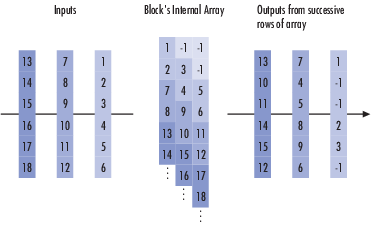comm.HelicalInterleaver
Permute input symbols using helical array
Description
The comm.HelicalInterleaver
System object™ permutes the symbols in the input signal by placing them in an array in a
helical arrangement and then sending rows of the array to the output port. For more
information, see Algorithms.
To helically interleave input symbols:
Create the
comm.HelicalInterleaverobject and set its properties.Call the object with arguments, as if it were a function.
To learn more about how System objects work, see What Are System Objects?
Creation
Description
intrlvr = comm.HelicalInterleaver
intrlvr = comm.HelicalInterleaver(Name=Value)NumColumns=6 sets the number of columns in the helical array to
6.
Properties
Usage
Input Arguments
Output Arguments
Object Functions
To use an object function, specify the
System object as the first input argument. For
example, to release system resources of a System object named obj, use
this syntax:
release(obj)
Examples
Algorithms
References
[1] Berlekamp, E. R. and P. Tong. "Improved Interleavers for Algebraic Block Codes." US Patent 4559625, Dec. 17, 1985.
Extended Capabilities
Version History
Introduced in R2012a
